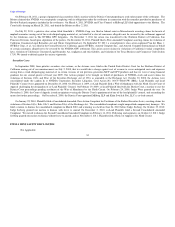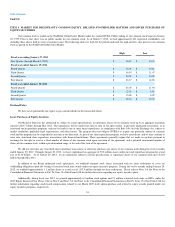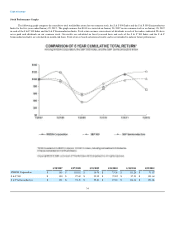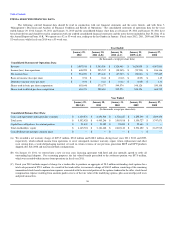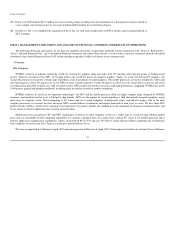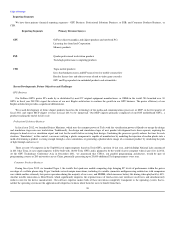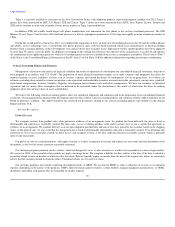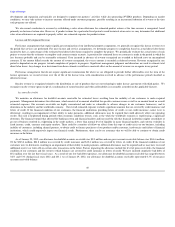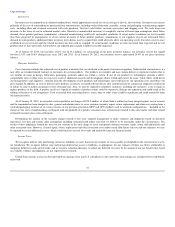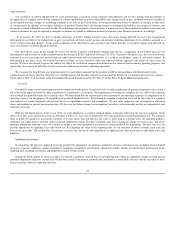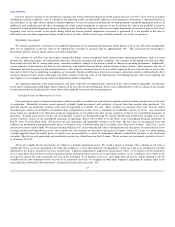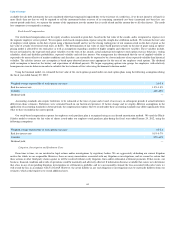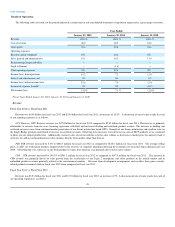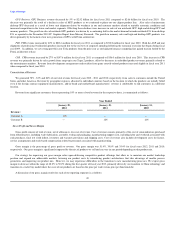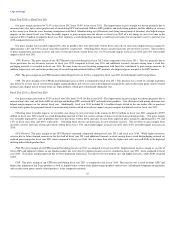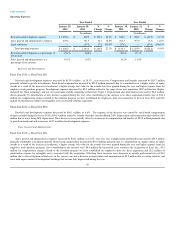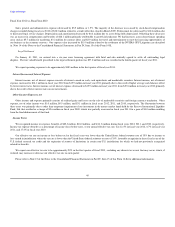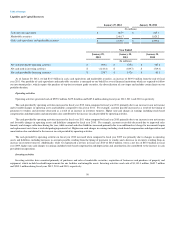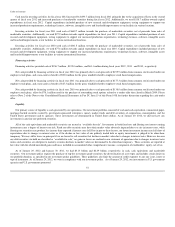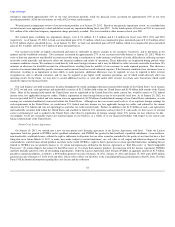NVIDIA 2012 Annual Report Download - page 43
Download and view the complete annual report
Please find page 43 of the 2012 NVIDIA annual report below. You can navigate through the pages in the report by either clicking on the pages listed below, or by using the keyword search tool below to find specific information within the annual report.
Table of Contents
Our calculation of current and deferred tax assets and liabilities is based on certain estimates and judgments and involves dealing with uncertainties in
the application of complex tax laws. Our estimates of current and deferred tax assets and liabilities may change based, in part, on added certainty or finality to
an anticipated outcome, changes in accounting standards or tax laws in the United States, or foreign jurisdictions where we operate, or changes in other facts
or circumstances. In addition, we recognize liabilities for potential United States and foreign income tax contingencies based on our estimate of whether, and
the extent to which, additional taxes may be due. If we determine that payment of these amounts is unnecessary or if the recorded tax liability is less than our
current assessment, we may be required to recognize an income tax benefit or additional income tax expense in our financial statements, accordingly.
As of January 29, 2012, we had a valuation allowance of $212.3 million related to state and certain foreign deferred tax assets that management
determined are not likely to be realized due, in part, to projections of future taxable income and potential utilization limitations of tax attributes acquired as a
result of stock ownership changes. To the extent realization of the deferred tax assets becomes more-likely-than-not, we would recognize such deferred tax
asset as an income tax benefit during the period.
Our deferred tax assets do not include the excess tax benefit related to stock-based compensation that are a component of our federal and state net
operating loss and research tax credit carryforwards in the amount of $526.0 million as of January 29, 2012. Consistent with prior years, the excess tax benefit
reflected in our net operating loss and research tax credit carryforwards will be accounted for as a credit to stockholders' equity, if and when realized. In
determining if and when excess tax benefits have been realized, we have elected to utilize the with-and-without approach with respect to such excess tax
benefits. We have also elected to ignore the indirect tax effects of stock-based compensation deductions for financial and accounting reporting purposes, and
specifically to recognize the full effect of the research tax credit in income from continuing operations.
We recognize the benefit from a tax position only if it is more-likely-than-not that the position would be sustained upon audit based solely on the
technical merits of the tax position. Our policy is to include interest and penalties related to unrecognized tax benefits as a component of income tax expense.
Please refer to Note 15 of the Notes to the Consolidated Financial Statements in Part IV, Item 15 of this Form 10-K for additional information.
Goodwill
Goodwill is subject to our annual impairment test during the fourth quarter of our fiscal year, or earlier if indicators of potential impairment exist, using a
fair value-based approach based on either a qualitative or a quantitative assessment. Our impairment review process compares the fair value of the reporting
unit in which the goodwill resides to its carrying value. We determined that our reporting units are equivalent to our operating segments, or components of an
operating segment, for the purposes of completing our goodwill impairment test. Determining the number of reporting units and the fair value of a reporting
unit requires us to make judgments and involves the use of significant estimates and assumptions. We also make judgments and assumptions in allocating
assets and liabilities to each of our reporting units. We base our fair value estimates on assumptions we believe to be reasonable but that are unpredictable and
inherently uncertain.
Effective the fourth quarter of fiscal year 2012, we early adopted an accounting standard update, commonly referred to the step zero approach, which
allows us to first assess qualitative factors to determine whether it is necessary to perform the two-step quantitative goodwill impairment test. For reporting
units in which the qualitative assessment concludes it is more likely than not that the fair value is more than its carrying value, the amended guidance
eliminates the requirement to perform further goodwill impairment testing. For those reporting units where significant change or event occurs, and where
potential impairment indicators exist, we continue to utilize a two-step quantitative assessment to testing goodwill for impairment. The first step tests for
possible impairment by applying a fair value-based test. In computing fair value of our reporting units, we use estimates of future revenues, costs and cash
flows from such units. The second step, if necessary, measures the amount of such impairment by applying fair value-based tests to individual assets and
liabilities.
Qualitative Assessment
In considering the step zero approach to testing goodwill for impairment, we perform a qualitative analysis evaluating factors including, but not limited
to, macro economic conditions, market and industry conditions, competitive environment, operational stability and the overall financial performance of the
reporting units including cost factors and budgeted-to-actual revenue results.
During the fourth quarter of fiscal year 2012, we utilized a qualitative analysis for several reporting units where no significant change occurred and no
potential impairment indicators existed since the previous annual evaluation of goodwill and concluded it is more likely than not that the fair value is more
than its carrying value on a reporting unit basis.
42


